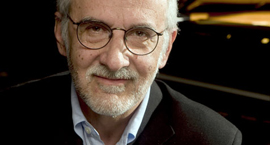|
|
>> Versão Portuguesa |
| Below the Exalted JELENA NOVAK |
2012.11.21 |
|
In the Introduction within the programme booklet Pinho Vargas explains that the “Requiem” was the initiative he proposed to the Music Department of the Gulbenkian Foundation. He started thinking about writing a “Requiem” after having been inspired with the concerts containing his oratorio “Judas” commissioned by the Festival Música Sacra de Viana do Castelo in 2004. As Pihno Vargas explains, he wanted to offer the reply to the history of numerous pieces of the same genre already existing in the history of music. On the other hand, he shows fascination with what he calls the universal cycle of humanity – birth, life, and death; and thus his “Requiem” should also be perceived from this perspective, as a musical treatise contemplating death and what comes after it. If I would like to situate this “Requiem” on a broad map of contemporary music languages, I would firstly put it in relation with what is called “new simplicity” and “holly minimalism” alluding to the music of authors such as Henryk Mikołaj Górecki, Arvo Pärt and John Tavener who combined conventions of different traditions of sacral music with repetitive music structures and relatively simple harmonic progressions. In the “Requiem’s” modal harmonic structures, and simple harmonic language I find references to the music of the Symphony of Sorrowful Songs by Henryk Mikołaj Górecki. In some harmonic combinations and sometimes in orchestration, I also find allusions to “Hollywood romanticism” often used in American commercial film industry. Finally, in occasional effective use of successive fifths and fourths I also find distant references to Gregorian chanting. Pinho Vargas' orchestra is voluminous and often loud, it “swallows” the listener through the depth and simplicity of its sound. The illusion of depth however is not achieved by harmonic “saturation” but rather by superimposing modal and unison layers. The effective use of unisons that combine instruments and voices have an outstanding presence due to the unison’s decisiveness. The role of the choir is dominant, and the orchestral part appears as being there primarily to give the context to the singing voices. The composer gave special attention to the particular choice of the text, being able to sometimes betray the typical choices. This “Requiem” consists of ten parts: Introitus, Kyrie, Dies irae, Fons pietatis, Confutatis maledictis, Lacrimosa, Offertorium, Sanctus, Agnus Dei and Libera me. The treatment of the text is clear and simple, generally syllabic. In each part of the piece the sung words were clearly perceivable. Apart from António Pinho Vargas, credits should also go to Paulo Lourenço, the choirmaster. The only interpretative problem in relation to the choir I found in Confutatis maledictis, when the sopranos had some difficulties in articulating their part. When I try, via “Requiem”, to understand António Pinho Vargas’ poetic relationship with death, the analogy with Edgar Allan Poe’s poem “The City in the Sea” arises. “No rays from the holy heaven come down And indeed, the death contemplated by António Pinho Vargas through his “Requiem” seems to be somewhere else, somewhere far away, down, below us. It is not even sinister, nor is it exalted. Its major dimension is its depth, gigantic, and provoking contemplation. The artist seems not to suggest that death is something that one should be afraid of, neither is he melancholic about it. Instead he seems to be fascinated by the floating abyss of thoughts, which it provokes. This transcendent perception of death and its musical embodiment seems to be the most valid Pinho Vargas' reply to the history of Requiems that gave him the impulse to write this piece in the first place. Barber’s melancholic “Adagio” and Stravinsky’s expressive “Symphony of Psalms” in the straightforward interpretation of Joana Carneiro created dynamic interlocutors to the “Requiem” that night. Approachability of these three pieces to the wider public, and a lively atmosphere in the audience made this classical music concert a vivid social event. Finding the sublime in simplicity and approachability Pinho Vargas answered to the question how and if Requiems should be written today, and how death could still be further contemplated by musical means. |
|
